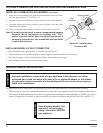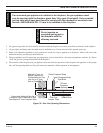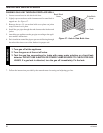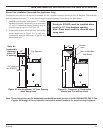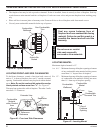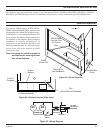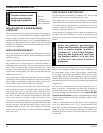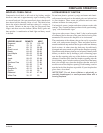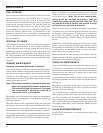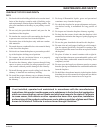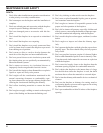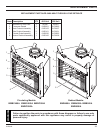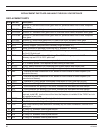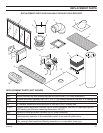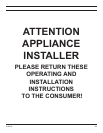
36 61D0006
MAINTENANCE
FUEL STORAGE
Wood can be dried sufficiently for burning within a few weeks
if protected form rain in a low humidity area. It is better to
cut wood and allow it to dry for a year. In all cases, the wood
should be stacked so that both ends of the sticks are exposed
to the air and protected from rain. The drier the wood, the
more usable heat produced by the fire and less likely rapid
accumulation of soot and creosote within the chimney is to
occur. See Chimney Maintenance for information on the
hazards of soot and creosote accumulation. Small quantities
of wood required for fire tending must be kept at least 30"
from the fireplace.
DISPOSAL OF ASHES
Ashes should be placed in a metal container with a tight fit-
ting lid. The closed container of ashes should be placed on
a noncombustible floor or on the ground well away from all
combustible materials until they are finally disposed of. If the
ashes are buried or locally dispersed, they should be kept in
the closed container until all cinder has thoroughly cooled.
Ashes should never be placed in a container with combustible
materials.
CHIMNEY MAINTENANCE
Creosote, Formation and Need for Removal
hen wood is burned slowly, it produces tar and other organic
vapors which combine with expelled moisture to form creo-
sote. The creosote vapors condense in the relatively cool chim-
ney flue of a slow-burning fire. As a result, creosote residue
accumulates on the flue lining. When ignited, this creosote
makes an extremely hot fire.
Note: The chimney should be inspected at least twice
a year during the heating season to determine
if a creosote buildup has occurred. If creosote
has accumulated it should be removed to
reduce the risk of a chimney fire.
The chimney cap can be removed for inspection, maintenance
and cleaning by removing three screws from the support legs
and lifting upward.
When the fireplace is new, inspect the chimney often and clean
the chimney any time creosote is seen on the flue walls. Once
you see a pattern of how often creosote is accumulating, you
can determine how often the chimney should be inspected.
Also changes in the outside environmental conditions such as
temperature and humidity or changes in the operation of the
fireplace can lead to rapid buildup of soot and/or creosote.
Have a a qualified and reputable chimney sweep clean the
chimney or remove creosote or soot with brushes on wooden
or fiberglass poles. Note: Do not use metal pipes,
chains, wires, etc., to clean the chimney. They can
scratch the surface of the stainless steel flue. This
will shorten the life of the flue and provide a rough
surface for soot particles to attach to.
Be sure to cover nearby furnishing and arrange some method
of catching soot and creosote particles that may fall during
the chimney cleaning process. If glass doors are installed on
the fireplace, they should be closed. Extra caution must be
used to avoid damage to the flue damper during the cleaning
process.
In addition to checking and cleaning the chimney on a regular
basis, be sure to inspect the chimney before starting a fire at
the beginning of each heating season. Make sure the chimney
is clear from any accumulation of soot, creosote or any other
debris. Make sure all joints are intact.
Monessen Hearth Systems does not recommend chemical
cleaners because some may contain elements that corrode the
metal parts of the chimney or fireplace.
FIREPLACE MAINTENANCE
At the end of each heating season or when the fireplace will not
be in use for an extended time, the ashes should be removed
and the hearth area should be swept clean. The slow absorption
of moisture into the ashes over a long period of time could
corrode metal fireplace parts.
At the beginning of each heating season, always operate the
flue damper and make sure it has not become stuck from soot,
creosote, etc.
Keep the lower and upper grille panels clean and free from
dirt and lint accumulation at all times to get the maximum
efficiency from your fireplace.
As you use the fireplace, expansion and contraction will cause
minor cracking of the hearth, back and side refractory mate
-
rials. This is normal and unavoidable. If the cracks become
large enough or parts dislodge and metal behind the refrac-
tory is exposed, the refractory panels should be replaced with
new panels. Obtain these panels Monessen Hearth Systems
fireplace dealer.
GLASS DOOR MAINTENANCE
For glass door maintenance, see instructions provided with
the glass doors.



